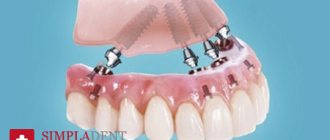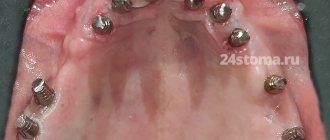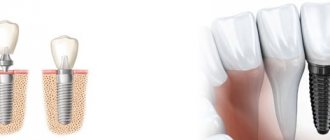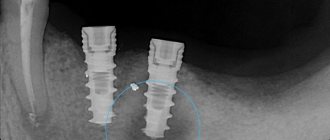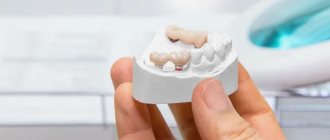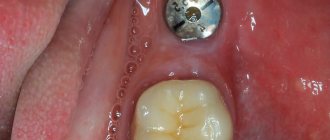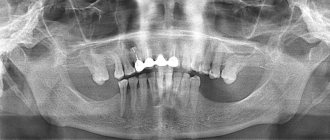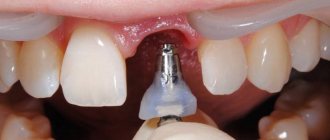What is basal implantation?
Let's try to give an analogy to make it clear what basal implantation is. If you place a stick in the ground using only the top loose layer, it will not hold well. But if you use deeper layers that are not washed out by water or exposed to other external influences, the stick can be secured much more firmly and will last longer. The same goes for basal dental implantation.
Basal complex is a type of implantation in one stage with immediate loading. The main difference between the basal implantation method and other protocols is that the installation of implants does not require the presence of alveolar cancellous bone, the most central part of the jaw bone tissue. It is used to install most classical implants. Basal implants work with fundamentally different sections: the cortical plate, basal bone, buttresses of the skull, nasal, zygomatic and sphenoid bone. To ensure that the bone and implant have a large contact surface, artificial roots are installed at a certain angle. Angling also helps to select the most suitable areas of bone and place implants bypassing the sinuses and nerve endings.
Unlike classic implants with a rough surface, basal implants are smooth and have a special antimicrobial coating. According to many studies, it is the absence of a rough surface in combination with the use of deep bone sections for implant installation that is an excellent prevention of peri-implantitis and, as a result, minimizes the risk of rejection in the long term. This is especially true in the presence of inflammatory processes in the oral cavity and periodontal tissues in particular.
The method is ideal for patients with complete edentia and is not suitable if only one tooth needs to be restored. The minimum is three missing teeth.
What is your dentist hiding from you?
After reading beautiful advertisements, some patients sit in the dentist’s chair without thoroughly understanding the method and experience of the specialists! During a face-to-face consultation with an implantologist, it is quite difficult for an ordinary person to make a decision - to trust the dentist or not? An experienced dentist will tell you both the pros and cons of each method used. However, some doctors miss some possible complications that may occur after undergoing treatment. Especially if there is not enough experience with total prosthetics of both jaws!
When choosing a clinic and doctor for basal implantation, pay attention to the dentist’s experience in total dental restoration! When performing basal implantation of both jaws, it is extremely important to take into account the pathology of the bite, the condition of the bone tissue, its quality and volume, as well as a study of the general health of the patients.
With a lack of experience, in addition to the loss of treatment results and rejection of implants - an extreme degree of complication, patients can acquire a number of seemingly insignificant, but extremely uncomfortable complications:
- A loose fit of the prosthesis to the gum leads to a lack of hygiene and an unpleasant odor
- If there is an error in prosthetics on the lower jaw, excessive salivation may occur
- An important aspect of total prosthetics is the restoration of the bite; lack of experience can lead to complications in the function of the temporomandibular joint (TMJ), which manifests itself as pain during chewing.
- Making a denture on the upper jaw requires sufficient skills of an orthopedic dentist so as not to cause speech dysfunction (difficulty in pronouncing hissing sounds)
- It is extremely important during the implantation process to install implants bypassing the maxillary sinus; some dentists claim that transsinus implantation (installation of implants through the maxillary sinus) does not cause complications, however, such statements end in long-term treatment of chronic sinusitis in the ENT office
- An experienced implantologist installs implants and manufactures prostheses with the expectation of further aesthetic prosthetics with metal-ceramic or other aesthetic prostheses.
- The key to the success of your future treatment lies precisely in the experience and manual skills of the implantologist, combined with the foresight of the orthopedic dentist! When restoring teeth using the basal express implantation method, your implantologist requires extensive knowledge of anatomy and skills in maxillofacial surgery!
Basal method of dental implantation - indications and contraindications
The main restrictions on refusing basal implantation are the absence of 1–2 teeth, as well as general contraindications to any other surgical intervention. At the same time, Basal complex allows you to solve problems that classical implantation cannot solve.
Indications for basal implantation are complete or multiple absence of teeth, which is accompanied by the following problems and needs:
- advanced forms of periodontitis and other dental diseases, when the only way out is their removal, for example, with a high degree of mobility or loss, in the presence of strong cystic formations on the roots;
- acute and chronic forms of gum disease, accompanied by severe recession of the gingival contour and exposure of the roots;
- inflammation and acute atrophy of spongy bone tissue;
- desire to change dentures to implants;
- the need to speed up treatment;
- reluctance or inability to grow bone;
- advanced age of the patient;
- restoration of teeth in experienced smokers.
What prosthetic possibilities does the technology offer?
The denture is usually placed 2-3 days after the implantation procedure. By this time, the orthopedic design will be ready, since its development begins at the stage of planning the operation - using the capabilities of three-dimensional computer modeling. Literally a couple of days break between direct implantation and installation of the prosthesis is necessary for minimal tissue restoration so that the prosthesis does not subsequently cause discomfort.
The first adaptive prosthesis assumes the presence of a strong base made of metal - it unites the implants and prevents them from changing their position even under chewing load. The acrylic part covers the uneven gingival margin, and lightweight plastic crowns allow you to return your smile to its former aesthetics and functionality. This design is fixed for a period of six months to a year, although its maximum operational period can reach 5 years (but with very good care).
How are crowns attached during basal implantation? In the case of the Basal complex, the fastening of crowns - or rather an extended prosthetic structure of 12 crowns and a gingival base - is done using cement. In all other one-stage methods (all-on-4, all-on-6), screw fastening is assumed, with the possibility of removing and relining the prosthesis. As for the Basal complex, a large number of implants are used at once, so in the future there is no need for large-scale correction of the prosthesis. And the metal base is simply sawed off when changing the prosthesis. But this does not affect the quality of implant fixation - you don’t have to worry.
A permanent orthopedic system gives the patient the opportunity to choose the material for the crowns: zirconium dioxide, ceramic composite or metal ceramics. This design will also include an acrylic part - artificial gum. If the patient decides to refuse it, he will have to undergo a gum plastic procedure, and then it will be possible to install a prosthesis consisting only of crowns (but this is not always possible, since implantation is often carried out against the background of an acute deficiency of both bone and mucous membrane) . But, as a rule, doctors do not recommend doing this, because in fact the gums come out poorly - they are uneven in rows and atrophied along with the bone. It is better to cover its contour with a small piece of acrylic gum, which will not be noticeable at all even with a wide smile, and even more so during a conversation.
Features of the Basal complex
- No bone grafting is required.
- Basal implantation and tooth extraction are easily combined and are carried out in just one approach.
- Before the operation, a thorough 3D diagnosis is carried out, as well as three-dimensional modeling of the treatment process.
- At the surgical stage, templates are used to facilitate the process of implantation and allow their installation to be carried out as accurately as possible. During the implantation process, all manipulations are also monitored using 3D X-ray diagnostic technologies.
- Prosthetics take place within 3 days to ensure chewing load on the bone. Dentures can be fixed to implants using either cement or screws.
- When using zygomatic implants, they are fixed at an angle, bypassing the maxillary sinuses.
- For basal implantation, solid one-piece or one-component implants are used in an amount of at least 8 pieces.
Peculiarities
One of the main features of basal implantation is the shape and size of the implants used. Various designs have been developed at different times. Practice of use has revealed shortcomings in some of them, which forced dentists in some countries to abandon their use. Other modifications have shown acceptable effectiveness and are widely used today.
Basal implantation is based on the following principles.
- Dense basal (cortical) bones are used to attach the implants.
- No bone grafting is performed.
- The instantaneous load method is used. The prosthetic structure is installed on the infrastructure no later than 7 days after the installation of the implants. Most often, dentures are installed within 1-3 days after implantation.
- Implants are not used individually, the smallest number of rods is 3 pieces. This is due to the need to ensure the stability of the structure in conditions of long implant lengths. To replace a completely toothless jaw with prosthetics, it is necessary to install 8-14 rods.
- Both screw and cement fixation of the prosthetic structure to the abutments can be used. Preference should be given to screw fixation, since it allows, if necessary, to disassemble the structure, treat bone and soft tissues, and correct the occlusion.
- Direct implantation is possible, that is, installing an implant in a fresh hole left after tooth extraction.
- During implantation, it is advisable to use 3D modeling and navigation to bypass dangerous areas, the main of which are the mandibular canal with the nerve bundle and the maxillary sinuses.
For implantation, basal and zygomatic implants are used, their shape and size significantly different from standard intraosseous structures. The main difference is the longer length of the rods (necessary to reach the deep basal bones), as well as the shape and location of the threads on the rod.
Why does the installation of basal implants take place without bone grafting?
Classic two-stage dental implantation is only possible if there is a sufficient amount of cancellous bone tissue. If there is a deficiency, bone augmentation is required before surgery. The basal method does not require this. Everything is explained simply:
- Other layers of bone are used, the density and hardness of which does not change due to the absence of teeth, since their chemical structure is different from the alveolar (spongy) layer.
- For the basal method, solid implants are used. They are often longer and thinner than the classic two-piece. This allows implants to be installed into the bone tissue at an angle with penetration into the deep layers.
- Basal implants are installed according to the principle of compression of bone tissue around its axis when screwed. That is, during implantation, the bone is not lost, but is compacted around the artificial roots. In this way, excellent primary stabilization is achieved with a force of up to 100 Newtons (for comparison: with the classical approach - no more than 30 - 40 Newtons). This approach has been used for more than 50 years for fractures and joint injuries. The principle of operation is also known by the name of the scientist-inventor G.A. Ilizarov.
- After fixing the implants in the bone, metabolic processes are immediately activated. The solution to this problem is taken over by the prosthesis. The patient chews food, improving blood supply to bone tissue. The cells are revived, replacing old and damaged ones, filling the space and increasing bone density around the artificial roots. Osseointegration occurs faster.
- The prosthesis has another important task - to fasten, connect or splint the implants with its frame, thus eliminating the risk of their mobility and displacement of the structure. The metal base connecting the implants to the prosthesis does not change its position even under heavy loads.
New or old technology?
The development of implantation since the 60s of the 20th century has been based on two different technologies. The founder of modern dental implantology, Swedish doctor Per-Ingvar Brånemark, came up with root-shaped implants that were implanted in two stages. The phenomenon of osseointegration, discovered by scientists from Sweden, proved that a titanium rod implanted into bone tissue was able to completely fuse with the bone, becoming motionless, strong, and stable.
American professor Leonard Linkov invented implantation systems similar to blades or thin plates (blades). To implant them, it was necessary to cut out a bed in the basal tissue of the bone, where a plate with a pin was placed. A crown was then placed on it, and the implant itself was integrated into the bones, overgrown with connective tissue.
At that time, basal dental implantation became an ideal option for those patients for whom root-shaped implants were contraindicated due to insufficient bone tissue for their implantation.
Later, basal technology was improved in 1982 by the French scientist Jean-Marc Julier. The scientist proposed an implant in the form of an inverted letter T with a longer root part than that of classical products. It was not installed in the spongy porous tissue of the jaw bone, where the roots of the teeth are located, as with traditional implantation, but in deeper layers - the basal ones.
At his instigation, the method of implanting implantation systems for bone tissue atrophy, if the patient has insufficient volume, began to be actively introduced in dental clinics in Europe. The basal bone is not subject to atrophy and has fewer capillaries. Such characteristics made it possible to carry out dental implantation even with a significant lack of the upper layer of the jaw bone.
However, by the beginning of the 90s, European dental associations agreed that the effectiveness of basal implantation was low. In practice, it turned out that implants implanted in this way served much less than root-shaped ones and could not withstand the chewing load.
However, the collapse of the Iron Curtain between Russia and Europe in the 90s opened the way for ineffective basal implantation in dental clinics in Russia and the CIS countries.
Pros and cons of basal implantation
- Time frame – prosthetics using this method will not take the patient much time. According to the protocol, implants should be “loaded” on day 3. Maximum taking into account the need to prepare for the operation, with all possible corrections of the prosthesis to suit the patient’s bite, compliance with the requirements for aesthetics and beauty of the smile, the entire treatment will take no more than 7 days.
- Appearance - the artificial gum is made of translucent acrylic, there is very little of it. When smiling and talking, no one will notice the border of the prosthesis. And the base will brilliantly cope with its task - it will protect the gums from injury in case of inflammation and hide existing cosmetic defects of the mucous membrane, if any.
- Rejuvenation is a pleasant “side” effect of prosthetics. Wrinkles around the mouth will be smoothed out due to the normalization of the functioning of the facial muscles.
- Pleasure from food - you can eat everything! Chewing food is welcome - it speeds up the process of bone tissue regeneration.
- Teeth can be restored even with a large deficiency of bone tissue.
- Contraindications - minimum. Even smoking, inflammation of bone tissue, periodontitis, and periodontal disease are not an obstacle to surgery. Implants work with deep parts of the bone, which are sterile and inflammation does not reach them.
- The implants are securely fixed - the fixation force is 2 - 3 times higher than that of classic models.
- Rehabilitation is very fast. Thanks to minimal trauma and the use of bio-membranes, which are created from the patient’s own blood plasma, tissues are quickly restored. There is only mild pain, comparable to the discomfort after tooth extraction. It goes away in 3 – 7 days. On an individual basis, the doctor prescribes antibacterial and painkillers that will reduce pain to “no”.
- The risk of implant rejection is minimal. Fixation in sterile parts of the bone tissue and preservation of the gums eliminate inflammation. An individually developed 3D plan for installing implants for each patient and the same control throughout the operation to install implants does not allow errors.
- The prosthesis is easy to care for.
- The prices are incredible. Basal implantation will cost less than classic two-stage implantation.
The main disadvantage of basal implantation is that Russia currently lacks qualified specialists. While implantation using the Basal complex method requires experience and knowledge. In one person, the doctor must be a surgeon with excellent knowledge of the anatomical structure of the maxillofacial system, an experienced orthopedist, an implantologist himself, as well as a competent user of software for modeling treatment results in 3D.
Basal implantation or Basal Complex is a solution for those with a complex clinical case
Article navigation
- Description of the technique
- Distinctive characteristics
- Indications and contraindications
- Preparing for surgery
- Implant fixation procedure
- Types of implants
- What prosthetic possibilities does the technology offer?
- Advantages of the method
- Disadvantages and complications
- What is the price
- Alternatives
Question for a specialist
Basal dental implantation refers to a special treatment tactic using basal implants, which are fixed in the deep layers of the jaw bone - in the area of the cortical plate and the basal layer. Here the bone tissue is denser and sterile, and therefore it is not afraid of either atrophic processes or various types of inflammation. This makes it possible to treat periodontal disease, periodontitis or osteomyelitis, and acute bone resorption. In most cases, the technique allows one to avoid bone augmentation, which is undoubtedly its advantage, since this is a rather expensive and painful procedure, which also significantly prolongs the treatment period. We will tell you more about the essence of basal implantation, its pros and cons, as well as cost later in this article.
Feature: up to 12 implants are used per row, which significantly improves the prosthesis fastening system and allows implantation even in the most difficult cases.
Treatment period: 3-5 days.
%akc54%
Computer-aided treatment planning
It is impossible to prepare for basal implantation without 3D technologies. Bone tissue will not grow, so it is important to carefully and accurately plan treatment. The computer helps you select a model, calculate the angle of inclination of the implant, and choose the ideal location for it.
Computed tomography is also strictly required. From the images you can evaluate the quantity, quality and characteristics of bone tissue. Implants should not touch the sinuses or nerves. The examination results are processed through a computer, and by the time treatment begins, the doctor is very clear about the next steps. A detailed plan for the placement of implants and the developed parameters of the prosthesis helps you not to go astray.
In addition to computer technology, when creating individual orthopedic structures, special devices are used to measure the characteristics of the patient’s bite and occlusion.
Before installing the implants, again using virtual modeling, an individual template is prepared from elastic material for each specific patient. It is fixed on the gums - this stencil allows you to install the implant perfectly and without displacement in accordance with the chosen location.
Features of installing implants of different modifications
Implantation is carried out according to protocols determined by the designs used.
Placement of lateral BOI/TOI is performed from the gingival side with a flap detachment. The bone bed is prepared according to the shape of the implant. The structure is installed in the sawn grooves, the free cavities are filled with a bone substitute, and the wound is sutured.
Screw implants ZSI, BCS, GBC are installed on top or slightly to the side of the alveolar process, screwed into channels drilled in the cancellous and basal bone. Drills of different diameters are used with a gradual increase in size. The channel size should be slightly smaller than the thread diameter. When the implant is inserted, compression of the bone tissue occurs, which ensures the stability of the structure and rapid osseointegration.
The choice of implant and installation location has many nuances.
In difficult cases, a flap is removed to determine the bone configuration. The best option is to use 3D implantation, which allows you to visualize the location of the smallest parts of the dentofacial apparatus.
Prosthetics occurs within 3 days after implantation. Basal technology involves the use of fixed prostheses. First, a beam is installed on the abutments to ensure rigidity and strength of the structure, then the prosthesis is attached.
What prostheses are used?
A model of the prosthesis is created before treatment using a computer program; the design is subsequently improved and verified using impressions, which are taken after the installation of basal implants. The mucous membranes need time to recover, so immediately after fixing the implants, the prostheses are not attached. It is recommended to wait 1 – 2 days.
For the first six months to a year, as a rule, an adaptive prosthesis with a metal frame and plastic crowns is installed (if desired, it can be left for its entire service life - up to 3 - 5 years). When the implants take root (and this will take a maximum of a year), the temporary prosthesis must be replaced with a permanent one. Crowns can be made of zirconium or metal ceramics.
But there is another option, which modern technologies allow: in 75% of cases, you can immediately install not a temporary, but a permanent prosthesis made of polymer materials. No need for re-prosthetics. Such a modern prosthesis lasts at least 10 years and is subject to adjustment to the bite directly in the patient’s mouth. The structure can be secured using cement or screw fastening.
Preparing for surgery using 3D visualization
The technology itself is designed for cases of acute bone tissue resorption - in such conditions it is extremely important to carefully plan each individual moment. Therefore, before the operation, specialists carry out step-by-step modeling of the entire treatment process using modern 3D technologies. Using specialized software, the optimal points for implants are selected, the angle of inclination of the structures is determined, their models are selected, and the prosthetic device is fitted taking into account occlusion. That is, how the jaws will close and how the load on the implants will be applied.
At the preparatory stage, the patient is sent for an X-ray examination. With the help of computed tomography (but in no case just a panoramic image), the doctor receives the most informative data about the condition of the jaw in three dimensions - they contain complete information about the condition and volume of bone tissue, the position of nerves, maxillary sinuses and other important elements. After this, the data is transferred to the program, where the treatment is planned - from the selection and inclination of implants to the installation of the prosthesis. In order to exclude possible contraindications, the patient is also referred for blood tests and to specialized specialists. But this is only if necessary.
What can be used instead of Basal complex?
One alternative solution is to install conventional removable dentures. However, the service life of orthopedic structures fixed only on the gums is short-lived, they are inconvenient to use, and they also lead to bone tissue atrophy, which requires frequent relining. An alternative may be solutions such as implantation of All-on-4 or All-on-6 - on four or six implants, respectively. These protocols are also used in cases of complete absence of teeth and involve implantation with immediate loading. But unlike basal implantation, they have certain limitations in the volume and quality of the jaw bone and are not used in cases of pronounced atrophic processes.
What dentists say
The opinions of dentists regarding basal implantation are ambiguous. Some are categorically against this technique, others accuse opponents of basal implantation of conservatism and even a lack of professionalism.
The chief physician of the Center for Reconstructive Surgery and Implantation believes that basal implantation is nothing more than an attempt to deceive the biomechanics of chewing. Non-root-shaped basal implants with the thickness of a matchstick do not withstand chewing overload. This leads to resorption of the last boundaries of the bone and rejection of the implants. Naturally, the results of basal implants with immediate loading are in many ways inferior to classical technology.
Other implantologists (including doctors of medical sciences, professors, academic members of the Russian Academy of Sciences), based on their many years of experience in implantology, are categorical in their statements, openly saying that basal implantation is “pure deception.” They insist that this is not an innovative, but rather a medieval method, and in no case should it be a full replacement for classical implantation.
Dentists with foreign experience criticize basal jaw implantation even more: they harshly condemn the method of filing non-removable abutments. According to the chief physician of one of the specialized private clinics, they stick out like anti-tank hedgehogs right in the client’s oral cavity. The doctor is surprised: “What does it mean to saw high-strength titanium in the mouth? Try sawing off a piece of metal reinforcement using your head as a support. And you will feel the fullness of the upcoming sensations. In a word, the most perfect collective farm and primitivism compared to modern Brånemark systems, where the implant and the superstructure (abutment) are not one whole.”
However, dentists do not categorically deny basal implantation, giving it a place in critically extreme cases when it is impossible to carry out the classical protocol:
- for serious injuries and injuries to the jaw bones;
- in most cancers associated with the loss of a large mass of tissue;
- with severe inflammation, acute bone resorption, large loss of tissue of the jaw bones and the impossibility of their growth.
Although, as practice shows, with the development of modern technologies for bone tissue restoration, the need for basal implantation is finally becoming a thing of the past.
Doctors recommend low-traumatic methods as an alternative to basal implantation
What is better – classic or basal implantation?
Basal implantation is indicated for complete or almost complete absence of teeth. It is carried out both in case of bone tissue deficiency and in the presence of acute forms of periodontal tissue diseases. Classic implantation will not work in this case - the operation requires bone tissue augmentation. And this is extremely difficult, expensive and will take a lot of time. Therefore, in such situations, patients often hear a refusal and a recommendation to stay with removable dentures. We can safely say that today there is no full-fledged alternative to the basal implantation technique, especially in complex clinical cases.
Which implants to choose - basal or classic?
So, on the one hand, the classic two-stage procedure is the most common and internationally recognized option for dental restoration. On the other hand, in some clinical situations it is more appropriate to perform basal implantation.
Among modern implantation methods, it is impossible to single out clearly good or bad. Only a doctor can select technologies that are suitable for a specific patient and his clinical case. Experienced dentists-implantologists of the “Full Order” clinics will select the appropriate method for restoring teeth, even in difficult cases.
Don't put off visiting your doctor! Just a few visits to the clinic can restore your health and the ability to smile freely.
Cost of treatment
The final price of basal implantation in Moscow depends on the complexity of the case, the manufacturer of the implants, as well as the materials of the selected denture. However, the patient always has a choice. Thus, the cost of basal implantation on the upper or lower jaw is 265 thousand rubles with an adaptive prosthesis, the service life of which is 3–5 years. With the installation of a permanent polymer ceramic-composite prosthesis, the installation of basal implants will cost 350 thousand rubles. With the fixation of a metal-ceramic prosthesis, the entire procedure will cost 450 thousand rubles.
Stage of permanent prosthetics –
After 2-3 years of wearing a temporary prosthesis, it will be necessary to replace it with a permanent one. Moreover, if you initially had a cement fixation of a temporary prosthesis, then changing it to a screw one will not be possible at the stage of permanent prosthetics. Screw-fixed prostheses are a priori better, but they are much more labor-intensive to manufacture and therefore are always more expensive.
Options for permanent fixed dentures:
- Metal-ceramic bridge prosthesis - it is very important that the metal frame of such a prosthesis is not cast, but made by milling. This option of prosthetics allows you to achieve quite decent aesthetics if high-quality ceramic mass is used and the clinic has a good dental technician. The price for a bridge prosthesis with cement fixation will be from 230,000 rubles, with screw fixation – 270,000 rubles.
- Ceramic composite prosthesis (option 1) - the prosthesis will be made on an individually milled titanium frame, but the frame will be simplified (there will be no stump for each artificial tooth). Artificial teeth and artificial gums will be made from a mixture of acrylic plastic and ceramic microparticles. This is a good option for a prosthesis, which will cost about 250,000 rubles if it is cemented, and 320,000 rubles if it is screwed.
- Ceramic composite prosthesis (option 2) - it will be made on an individually milled premium titanium frame (where the titanium beam will have a stump for each artificial tooth). The frame will be lined with ceramic composite on the outside, and the artificial teeth will also be made of ceramic composite. This is an excellent option for a prosthesis, which, subject to cement fixation, costs about 400,000 rubles, and subject to screw fixation – 420,000 rubles. We draw your attention to the fact that if the difference in cost is not critical for you, then when choosing a ceramic-composite prosthesis, it is better to choose a manufacturing option where the titanium beam will have a stump for each artificial tooth. This ensures high strength of fixation of artificial teeth and reduces the risk of their breakage, which is quite possible in the absence of stumps.
- Zirconium dioxide bridge – such a prosthesis will have an individually milled zirconium frame inside, coated on the outside with denture ceramics. Artificial teeth will also be made of zirconium dioxide. This is a very aesthetic version of the prosthesis, which will look especially advantageous on the upper jaw. Its cost, subject to cement fixation, will be about 320,000 rubles, subject to screw fixation - about 370,000 rubles.
Important features of zirconia bridges:
If it is planned to make artificial crowns also from zirconium dioxide in a bridge made of zirconium dioxide, then it is not recommended to make them in the form of single crowns. It is better to make them in three blocks, similar to bridges (a block of 6 front teeth + two blocks for the chewing groups of teeth). Thanks to this, there will be only 3 seams between the artificial teeth, which will protect the prosthesis from darkening and odor.
But there are also zirconia bridges where single E-max ceramic crowns are used as artificial teeth. Such prostheses look impressively beautiful, but only for the first time. In the future, such dentures quickly darken in the area between the teeth (where the seams between the artificial crowns are located), and also begin to smell not very pleasant. But it will not be possible to solve this problem by making blocks of several crowns, because Emax crowns can only be single.
Well, the last recommendation is that if you are planning basal implantation on two jaws at once, then a zirconium dioxide bridge can be made only on 1 jaw (preferably on the upper one), and on the second - only a ceramic composite prosthesis. If you make zirconium dioxide on two jaws at once, then after 2-3 years it will end with the breakage of one of the dentures.
Option for permanent prosthetics IMMEDIATELY after surgery –
Patient reviews of basal implantation are often positive for only one reason - this type of implantation allows us to avoid the stage of temporary prosthetics and makes it possible to immediately install a permanent fixed denture. With other methods of implantation and prosthetics in the complete absence of teeth (for example, All-on-4 or All-on-6), we have the opportunity to first make only a temporary fixed prosthesis.
In this case, the prosthesis is made from a ceramic composite (a combination of acrylic plastic and ceramic microparticles), from which both artificial teeth and pink artificial gums will be made. Inside, such a prosthesis will have an individually milled titanium frame (CAD/CAM technology). In addition, such a prosthesis will require screw fixation on Multi-unit abutments. The cost of this prosthetic option will be 580,000 rubles.
Those. in this case, we save approximately 65,000 rubles on the cost of a temporary fixed prosthesis, and immediately receive a permanent screw-fixed prosthesis. Moreover, this also turns out to be much cheaper than the All-on-4 technique, where the cost of installing implants (taking into account a similar type of permanent fixed prosthesis) will cost no less than 700,000 rubles.
Recommendations for choosing a clinic and implantologist
As mentioned above, basal implantation in the form in which it allows you to achieve high results is practiced today by very few specialists. In order not to run into a “fake” and not to become a victim of inexperienced doctors, but to get a guaranteed high result of the work done, I recommend paying attention to the following points.
The most important thing is that the doctor has a certificate issued by the International Implant Foundation. It is this association that has been actively studying and introducing into practice methods of one-stage implantation with immediate loading for many decades, including the basal complex. Currently, the foundation has introduced a five-step training that every specialist practicing these protocols must undergo. Naturally, the doctor must be accredited by the company that manufactures the basal implants.
What are the types of implants for this concept?
Doctors have been using BOI implants for quite a long time. They had a flat part at the base, which was precisely fixed in the basal layer. However, such models ceased to be used over time, since they assumed a very traumatic installation, as well as a high probability of rejection. Gradually, specialists switched to the use of improved dental implants - basal and compression (see photo below). But it was the discs that essentially gave rise to the development of understanding of the process of basal implantation. Today, one-piece structures with angled abutments are used for implantation; their angle of inclination is adjusted after fixation of the implant. They are often longer than classic designs and equipped with compression or active threads. As noted above, implants have a smooth neck and an antibacterial layer.
If we talk about brands, then we can only consider Oneway Biomed (Switzerland). Some other clinics offer ROOTT models, but in fact they are a complete copy of Biomed, since Biomed was originally developed for immediate loading, to solve problems of complete adentia in complex clinical cases, to use the basal region. And this company has existed for more than 40 years, during which it conducts numerous clinical studies.
Alternative methods of dental implantation
Basal Complex is performed in complex clinical cases when the classical method is not possible due to thinning of the bone tissue. The center offers patients similar systems with single-phase loading from proven brands. For prosthetics on implants use:
- Nobel BioCare All-on-4/6;
- ]Straumann Pro-Arch[/anchor] systems;
- MegaGen with unified protocols;
- classic method with tissue extension.
There are not many specialists of this level in Belarus. Our surgeons and orthopedists have undergone foreign practice and have the appropriate licenses. You can read about the work of specialists in the reviews section.
The article was prepared by a specialist:
Basal dental implants: types and prices
Since Basal complex treatment regimens are not the most popular, there are few companies producing the corresponding series. The most popular brands are Roott implants and some Nobel lines.
There are 2 main types of basal implants:
- Classic, with a significant thread diameter. They are characterized by high mechanical stability and are tightly fixed even in severely degraded bone areas.
- Compression, characterized by the presence of compression threads. When screwed in, the screw compacts the bone around the implant, firmly securing it. Artificial roots are suitable for installation in cases of severe atrophy of bone tissue and in narrow areas of the jaw up to 2.5-3.0 mm wide.
Other options for solving the problem of complete absence of teeth
We have already said that basal technology is used in cases of complete or almost complete loss of teeth. This is the only concept that allows treatment even in cases of severe inflammation and acute bone resorption. In simpler clinical cases, one-step protocols may be alternative solutions to the problem:
- prosthetics on 4 implants: the main one here is the All-on-4 protocol from Nobel, but Straumann also has a similar concept - the technique is called Pro Arch. In both cases, only 4 structures are fixed, two of which are oblique in the distal sections. On the same day or within a week, a prosthetic device is installed on them. Most often, there is no need for bone grafting, but the method is indicated only for cases of slight atrophy of the alveolar ridge. If atrophy is severe, zygomatic implants can be used. The only difference between the protocols is that each of them involves the use of its own products,
- All-on-6 concept: this technique is used for more pronounced atrophic processes in the bone and involves the implantation of 6 implants at once on one jaw - 2 on the sides at an angle. This protocol can also use zygomatic implants, so it can be considered a full-fledged alternative to Basal Complex.
Modern one-stage implantation techniques have made smile restoration accessible to a wider range of patients, and this is good news. Now becoming the happy owner of beautiful and straight teeth is much easier and faster than it was literally 10 years ago. The use of computer technology has made it possible to minimize the risk of complications, so there is no need to be afraid of treatment. It is much more dangerous to ignore the problem of missing teeth in the mouth for too long, which sooner or later leads to disastrous consequences - from deformation of facial features to the development of serious pathologies of the oral cavity.
According to the results of studies conducted by the International Association of Implantologists (IIF).
Author: Bespalov R. D. (Thank you for your help in writing the article and the information provided)
How much will the treatment cost?
How much does basal dental implantation cost? It is quite difficult to announce the exact price, since the full cost, including prosthetics (installation of a prosthetic structure) will depend on many different factors. Including the type and number of implants (basal or compression), the condition of the bone tissue and the price category of the clinic you contact. On average, restoration of a complete dentition - the entire lower or upper jaw, using the Basal Complex system with fixation of 8 to 12 implants will cost 280-300 thousand rubles. The price is for the restoration of one jaw and includes the installation of a temporary metal-plastic prosthesis on a frame created according to the personal parameters of the patient’s dentofacial apparatus.
How much does basal implantation of two jaws cost at once? Complete restoration of teeth with the installation of 16 to 24 implants and an adaptive prosthetic design will cost approximately 500 thousand rubles. But these are only indicative prices for a more complete understanding of the picture. In each individual case, the cost may vary.
What are the advantages of the method?
When looking for an option for restoring teeth, you need to carefully study the pros and cons of each method. Moreover, it is important here to be able to separate truth from fiction, because reviews about basal implantation on the Internet are still quite contradictory. And opponents of the concept often list only the disadvantages, suggesting that outdated BOI implants are still used for the Basal complex. But in reality this is not the case - and progressive implantologists, keeping up with the times, do not find any disadvantages in the modern concept. Let's look at the benefits in the table below.
| Arguments in favor of Basal complex | Brief explanations |
| Treatment speed | from 3 to 7 days |
| High aesthetic characteristics | The denture has a small acrylic part that imitates natural gum. At the same time, the material is translucent, and the boundary between it and the gum is almost impossible to see |
| The opportunity to return to your normal lifestyle in the shortest possible time | The prosthesis, which is fixed after surgery, ensures complete restoration of the dental system. With it, you can immediately begin to chew normally, gradually increasing the load. Pressure is transferred to the implants and bone, which only contributes to rapid recovery and successful osseointegration |
| Low requirements for the condition and volume of bone tissue | Elongated implants sink deep enough into the bone, into those areas that are not afraid of atrophic processes (including the chin area, cheekbones). In addition, they are installed obliquely, which also improves the quality of their fastening |
| Minimum number of contraindications | The technology is successfully used for periodontal disease, periodontitis, osteoporosis, and allows heavy smokers to return a beautiful smile. The implants have a smooth neck that prevents plaque accumulation, as well as an antibacterial layer that actually helps stop inflammation |
| High rates of primary stability of implants | The rate of primary fixation for basal structures is several times higher than for models using the classical technique. The product is screwed into the bone, due to which a compression effect is created - the surrounding hard tissues begin to compact, which allows them to better hold the implant |
| Minimal likelihood of developing peri-implantitis | Sterile areas of the bone are used, and the implants themselves are implanted without unnecessary trauma to soft tissues. In addition, the antibacterial layer serves as an excellent prevention of peri-implantitis. At the same time, the implants themselves are in contact with the gums, but they have a smooth surface, so bacteria do not accumulate on them - and this is the main reason for the development of inflammatory complications |
| Easy to care for prosthetic device | There is a small space between the acrylic base of the prosthesis and the gingival edge, due to which maintaining the hygiene of the oral cavity, prosthesis and even the tops of the implants is not difficult |
| Financial accessibility of treatment | When choosing basal or classic implantation, it is worth considering that the first will cost several times less, which is largely due to the refusal of additional procedures (bone grafting, sinus lift) and the speed of treatment in general. Those. although the price is lower, it does not come at the expense of quality |
| Rejuvenation effect | After recovery, patients note a gradual smoothing of fine wrinkles, including in the corners of the mouth - because When chewing food normally, muscle function is activated |
